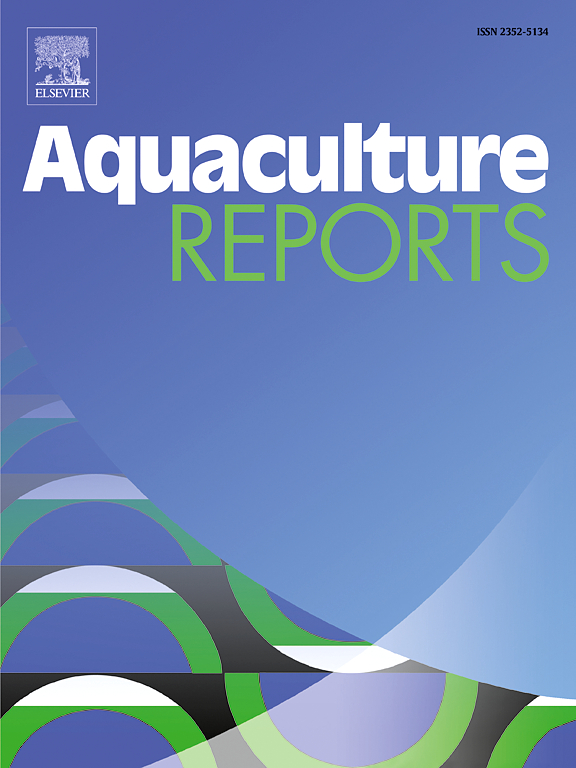The adaptive mechanism of Ctenopharyngodon idellus to dietary lipid levels: Insights from microbiota-mediated bile acid enterohepatic circulation
IF 3.2
2区 农林科学
Q1 FISHERIES
引用次数: 0
Abstract
Dietary lipid intake can dramatically alter the host microbiota and bile acids (BAs) metabolism. To explore the effect of endogenous BAs and intestinal microorganisms in the adaptive mechanism of grass carp (Ctenopharyngodon idellus) to different dietary lipid levels, triplicate groups of grass carp were fed three isonitrogenous diets with low (2 %), normal (6 %) and high (10 %) lipid levels and named group E2, E6 and E10, respectively. Results showed that a 6 % dietary lipid level was optimal for achieving the maximum growth performance and maintaining the liver health state of grass carp. The levels of glucose (GLU), high-density lipoprotein cholesterol (HDL-C), and malonaldehyde (MDA), along with the activities of acetyl-coA carboxylase (ACC), carnitine palmitoyl-transferase 1 (CPT1), fatty acid binding protein (FABP) and fatty acid transport protein (FATP) were significantly lower in fish that fed diet E2 than those that fed diet E6 (P < 0.05). The activities of acid phosphatase (ACP), alkaline phosphatase (AKP), glutamic oxalacetic transaminase (GOT) and glutamic-pyruvic transaminase (GPT) were significantly higher in fish fed diet E10 than in those fed diet E6 (P < 0.05). While there were no notable differences in the activities of lipid metabolism-related enzymes between fish fed diets E6 and E10 (P > 0.05), fish fed diet E10 exhibited a greater presence of vacuoles and lipid buildup in the liver compared to fish on diet E6. In the gallbladder, the levels of multiple BAs in fish that were given diet E2 were considerably lower than those in fish that received diet E6. However, the intestinal contents of fish that were given diet E2 showed significantly higher levels of multiple BAs than those on diet E6, while fish on diet E10 exhibited the opposite pattern. Additionally, fish fed diet E6 showed a higher presence of Fusobacterium and Cetobacterium, while the ratio of Proteobacteria decreased. Furthermore, multiple BAs were positively correlated with lactic acid bacteria-related genera from Firmicutes and a significant negative correlation with dietary lipid levels. These findings indicated that microbial-mediated bile acid hepatoenteric circulation plays an important role in the adaptive mechanism of fish to different dietary lipid levels, and it is expected to be an important intervention target for lipid metabolism disorders of grass carp.
草鱼对饲料脂质水平的适应机制:来自微生物介导的胆汁酸肠肝循环的见解
膳食脂质摄入可以显著改变宿主微生物群和胆汁酸(BAs)代谢。为探讨内源BAs和肠道微生物对草鱼(Ctenopharyngodon idellus)对不同饲料脂质水平的适应机制的影响,采用3个重复组分别饲喂低(2 %)、正常(6 %)和高(10 %)3种等氮饲料,分别命名为E2、E6和E10组。结果表明,饲料脂肪水平为6 %时,草鱼能获得最大生长性能并维持肝脏健康状态。饲料E2组的葡萄糖(GLU)、高密度脂蛋白胆固醇(HDL-C)和丙二醛(MDA)水平以及乙酰辅酶a羧化酶(ACC)、肉毒碱棕榈酰转移酶1 (CPT1)、脂肪酸结合蛋白(FABP)和脂肪酸转运蛋白(FATP)活性显著低于饲料E6组(P <; 0.05)。饲料E10的酸性磷酸酶(ACP)、碱性磷酸酶(AKP)、谷草转氨酶(GOT)和谷丙转氨酶(GPT)活性显著高于饲料E6 (P <; 0.05)。饲料E6和饲料E10在脂质代谢相关酶活性方面无显著差异(P >; 0.05),饲料E10在肝脏中表现出更多的空泡和脂质堆积。在胆囊中,饲喂饲料E2的鱼的多种ba水平明显低于饲喂饲料E6的鱼。然而,饲料E2组的肠道内容物中多种BAs含量显著高于饲料E6组,而饲料E10组则相反。此外,饲料E6中梭杆菌和鲸杆菌的含量较高,变形杆菌的比例降低。此外,多种BAs与厚壁菌门乳酸菌相关属呈正相关,与膳食脂质水平呈显著负相关。上述结果表明,微生物介导的胆汁酸肝肠循环在鱼类对不同饲料脂质水平的适应机制中起重要作用,有望成为草鱼脂质代谢紊乱的重要干预靶点。
本文章由计算机程序翻译,如有差异,请以英文原文为准。
求助全文
约1分钟内获得全文
求助全文
来源期刊

Aquaculture Reports
Agricultural and Biological Sciences-Animal Science and Zoology
CiteScore
5.90
自引率
8.10%
发文量
469
审稿时长
77 days
期刊介绍:
Aquaculture Reports will publish original research papers and reviews documenting outstanding science with a regional context and focus, answering the need for high quality information on novel species, systems and regions in emerging areas of aquaculture research and development, such as integrated multi-trophic aquaculture, urban aquaculture, ornamental, unfed aquaculture, offshore aquaculture and others. Papers having industry research as priority and encompassing product development research or current industry practice are encouraged.
 求助内容:
求助内容: 应助结果提醒方式:
应助结果提醒方式:


